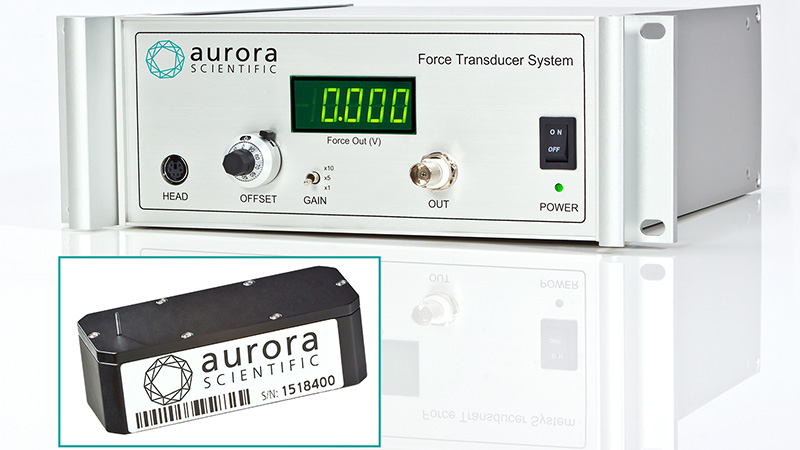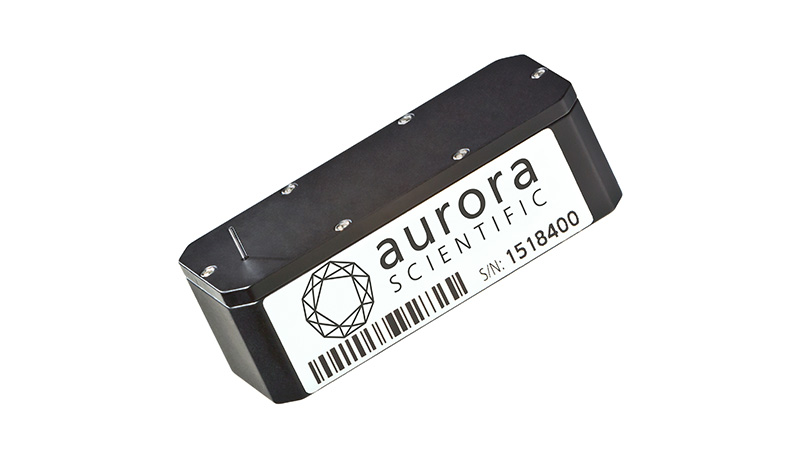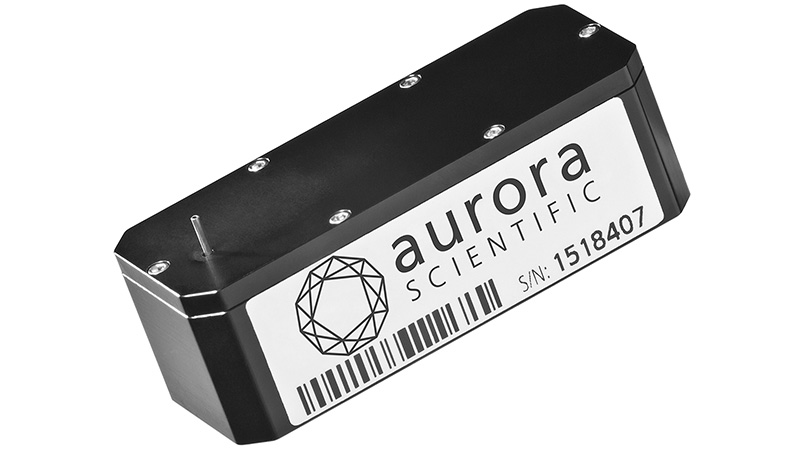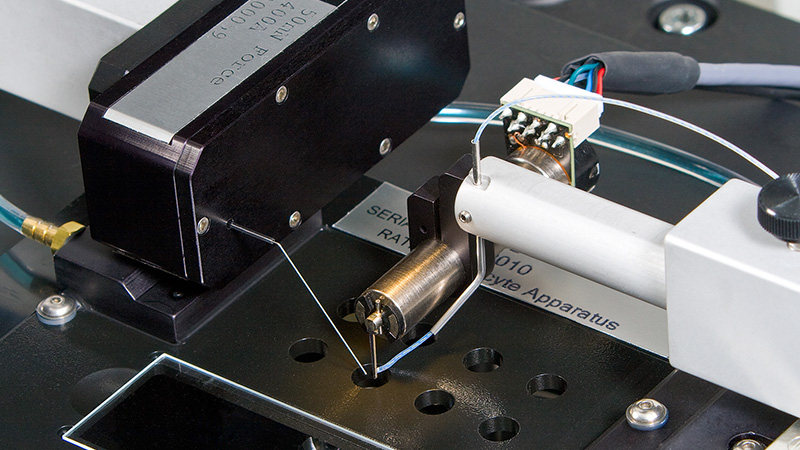There is a new version of this product available. Check out the 400C Series of Force Transducers!
400B: Force Transducers
The 400B series of force transducers is the next generation of our widely used 400A series. This new series advances the design by moving the sensitive signal processing circuitry into the transducer head itself. These new circuits allow any sensor head in the series to be plugged into the control electronics. Researchers can now purchase multiple heads to cover different force ranges, or as spares, and use them with a single controller. Other benefits of the new design are reduced noise, increased sensitivity and greatly improved linearity.
The 400B series of isometric force transducers enables contractile measurements from a variety of muscle types and sizes and are designed to meet the needs of muscle researchers. Each model is capable of measuring force in both tension and compression. These transducers are more robust and have less compliance than typical semi-conductor strain gauges. Physiologists now have a reliable and more economical way to quickly measure the contractile properties of all muscle types and connective tissue.
There are seven models in the series with the most sensitive model featuring a resolution of 10nN (1 microgram). With a frequency response up to 4kHz, researchers can measure forces from individual cells, single fibers and whole muscle covering a force range from 0.5mN to 1000mN.
Researchers can confidently measure force with extremely low compliance (<5µm at full load), eliminating any significant length change in the sample. The design provides excellent thermal stability and minimal sensitivity to vibration and interference. It also provides reliability and ease-of-use without troublesome compensation and filtering techniques.
Models
Complete, ready-to-use force transducers designed for fast response, high resolution and low compliance measurement of mechanical properties, ranging from 0.5mN to 1000mN:
400B: 50mN
402B: 500mN
403B: 5mN
404B: 100mN
405B: 10mN
406B: 0.5mN
407B: 1000mN
Variants
Available Sensor Heads:
400B-HD: 50mN
402B-HD: 500mN
403B-HD: 5mN
404B-HD: 100mN
405B-HD: 10mN
406B-HD: 0.5mN
407B-HD: 1000mN
Stories of Success
400A – Studying cancer cachexia in mouse models
CHALLENGE
In 2011 Dr. Theresa Guise and her colleague Dr. Andrew Marks approached Aurora Scientific seeking help in functionally characterizing muscle from their mouse tumor model. They were looking to assess the progression of muscle loss and weakness in these mice and investigate potential therapies.
Because the pathology in these mice was incredibly aggressive, many animals would need to be tested in a short period of time. This would necessitate the use of multiple rigs and a robust transducer that allowed for high throughput. Because Dr. Guise was only looking to perform basic isometric strength and fatigue measures, a dual-mode lever system would have been prohibitively expensive for its capabilities.
SOLUTION
Enter the Aurora Scientific 407A. As the transducer in the 400A series with the greatest force measurement capacity, it was suitable for making isometric force measurements in whole skeletal muscle from mouse. The unit is the most robust out of the whole 400A series, lessening the risk of accidental damage. The 407A was effectively paired with a modified 800A in-vitro muscle apparatus, as well as our 701C electrical stimulator and 615A DMC/DMA software.
RESULTS
The 407A transducer helped the labs of Dr. Guise and Dr. Marks to test many mouse models of cancer cachexia and performed so well that several more units were required in both labs to keep up with demand. Using the Aurora Scientific 407A, these researchers were ultimately able to determine the mechanisms and pathways that cause muscle weakness associated with various cancers. These results and many others were recently published in Nature Medicine.
Select References
- Hennequin, Yves et al. “Synthesizing microcapsules with controlled geometrical and mechanical properties with microfluidic double emulsion technology.” Langmuir (2009) DOI: 10.1021/la9004449
- Malisoux, Laurent et al. “Stretch-shortening cycle exercises: an effective training paradigm to enhance power output of human single muscle fibers.” Journal of Applied Physiology (2006) DOI: 10.1152/japplphysiol.01027.2005
- Frontera, Walter R. et al. “Strength training in older women: early and late changes in whole muscle and single cells.” Muscle & Nerve (2003) DOI: 10.1002/mus.10480
- Krivickas, Lisa S., Ronan Walsh, and Anthony A. Amato. “Single muscle fiber contractile properties in adults with muscular dystrophy treated with MYO‐029.” Muscle & Nerve (2009) DOI: 10.1002/mus.21200
- Ng, Rainer et al. “Poloxamer 188 reduces the contraction-induced force decline in lumbrical muscles from mdx mice.” American Journal of Physiology - Cell Physiology (2008) DOI: 10.1152/ajpcell.00017.2008
- Frontera, Walter R. et al. “Muscle fiber size and function in elderly humans: a longitudinal study.” Journal of Applied Physiology (2008) DOI: 10.1152/japplphysiol.90332.2008
- Deguise et al. “Motor transmission defects with sex differences in a new mouse model of mild spinal muscular atrophy” EBioMedicine (2020) DOI: 10.1016/j.ebiom.2020.102750
- Li, Chuan, Mark Ahearne, and Kuo-Kang Liu. “Micromechanical characterization of hydrogel-based contact lens.” International Journal of Modern Physics B (2010) DOI: 10.1142/S0217979210064046
- Ahearne, Mark et al. “Mechanical characterization of biomimetic membranes by micro-shaft poking.” Journal of The Royal Society Interface (2008) DOI: 10.1098/rsif.2008.0317
- Zucchetti et al. “Influence of external forces on actin-dependent T cell protrusions during immune synapse formation” Biology of the Cell (2021) DOI: 10.1111/boc.202000133
Related Products

300C: Dual-Mode Muscle Levers
Seamless, flexible control of force and length, with the unique ability to measure one or both in a single and convenient lever system.
Learn More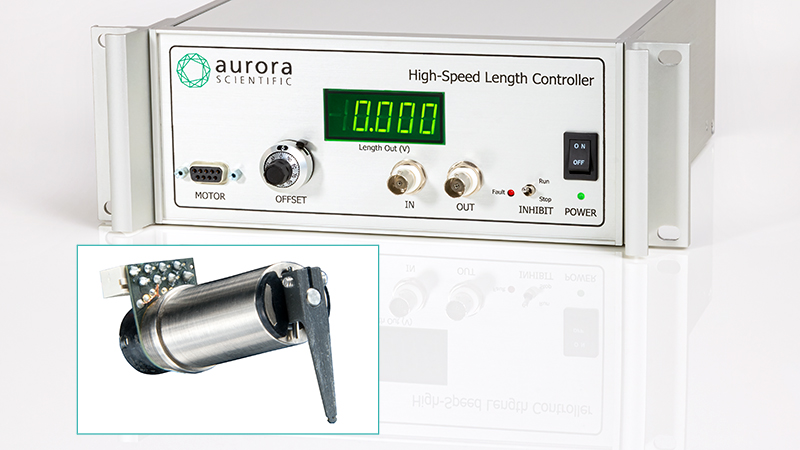
315D/322D: High-Speed Length Controllers
The 315D/322D High-Speed Length Controllers give physiologists the ability to control and measure length of single cells, fibers and whole muscle with ease.
Learn More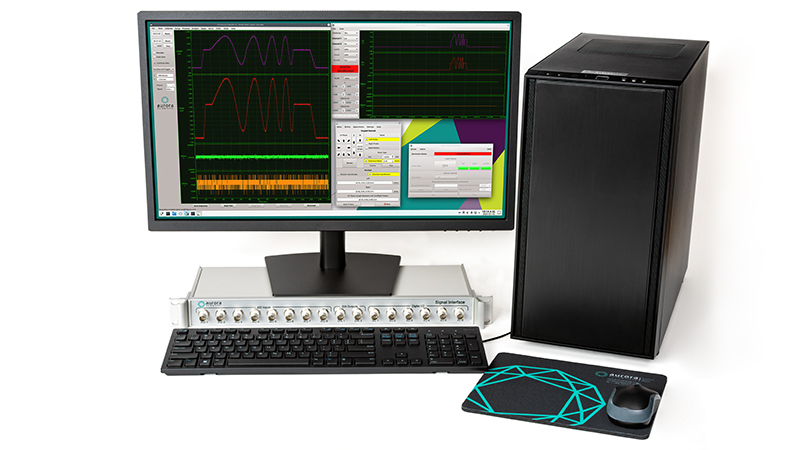
600A: Real-Time Muscle Data Acquisition and Analysis System
The 600A Digital Controller serves to integrate components and provide the researcher control of system operations, data collection and signal analysis.
Learn More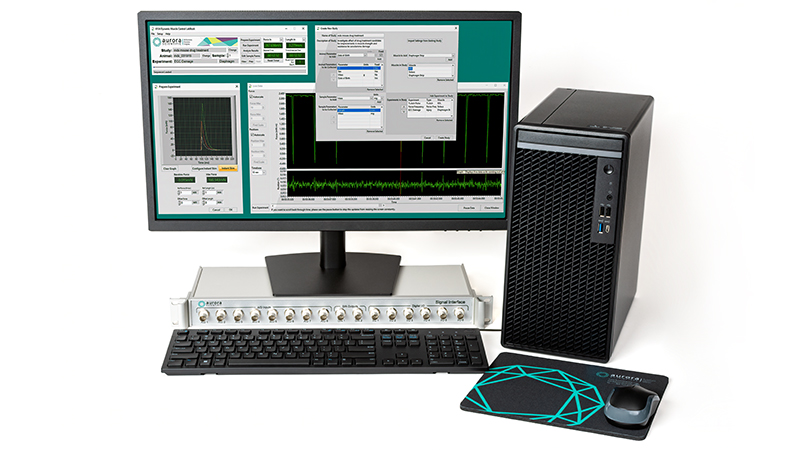
605A: Dynamic Muscle Data Acquisition and Analysis System
Precise, custom software designed for real-time data acquisition, instrument control and data analysis with unique, integrative features. Includes force and SL control capability
Learn More
701C: Electrical Stimulator
Our high-powered, bi-phase stimulator designed for muscle researchers conducting the most demanding field stimulation protocols.
Learn More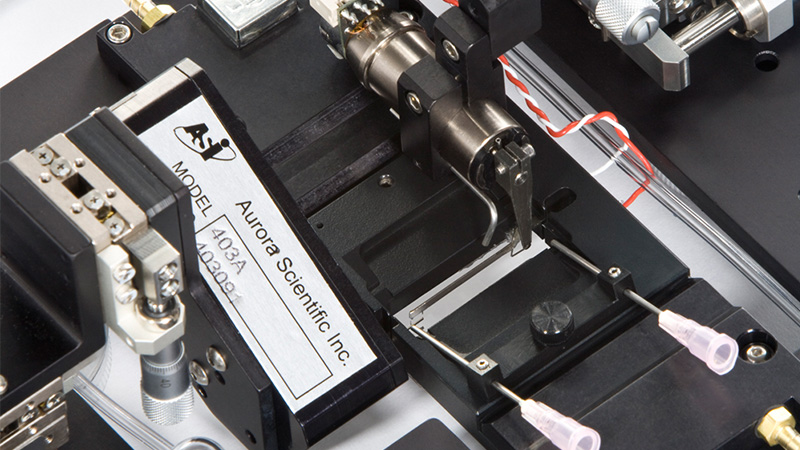
801C: Small Intact Muscle Apparatus – Microscope Mountable
Highly integrated apparatus, optimally designed to test small, intact muscle contractility
Learn More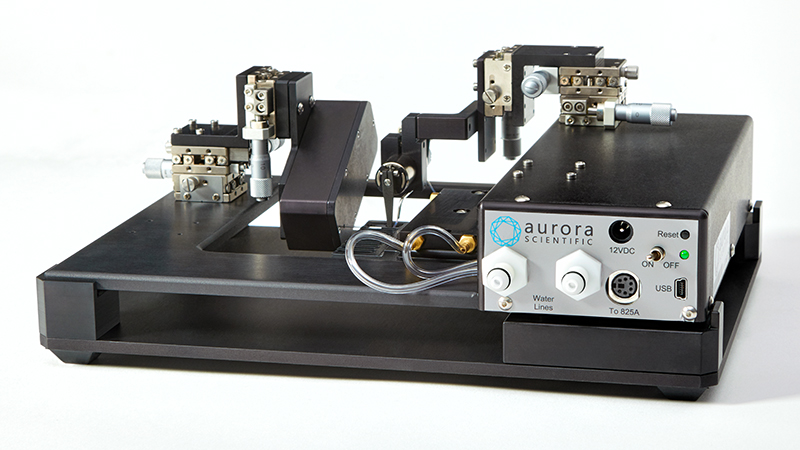
802D: Permeabilized Fiber Apparatus – Microscope Mountable
A multi-well automated test system for quick and accurate measurement of permeabilized fiber dynamics
Learn More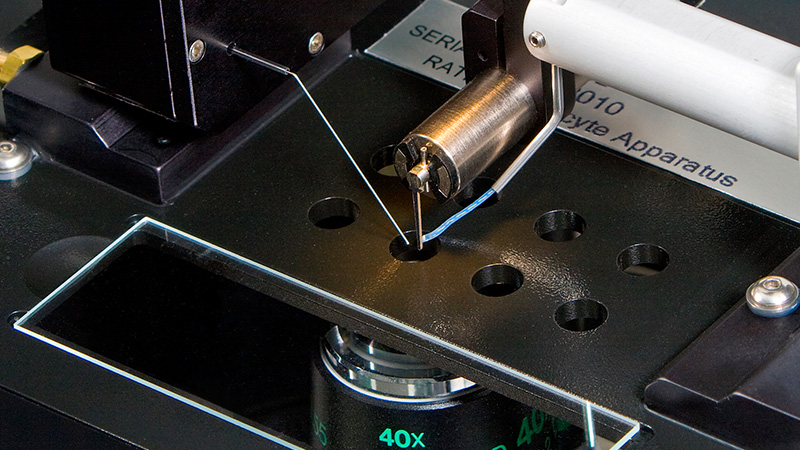
803B: Permeabilized Myocyte Apparatus – Microscope Mountable
Innovative 8–well plate designed for quick cell attachment and measurement of myocyte mechanical properties
Learn MoreRelated Systems
Specifications
| Force Specifications | 400B | 402B | 403B | 404B | 405B | 406B | 407B |
|---|---|---|---|---|---|---|---|
| Maximum Force [± mN] | 50 | 500 | 5 | 100 | 10 | 0.5 | 1,000 |
| Resolution [µN] | 1.0 | 10.0 | 0.1 | 2.0 | 0.2 | 0.01 | 20.0 |
| Scale Factor [mN/Volt ±2%] | 5.0 | 50.0 | 0.5 | 10.0 | 1.0 | 0.05 | 100.0 |
| Signal Linearity1 [%] | 99.9 | 99.9 | 99.9 | 99.9 | 99.9 | 99.9 | 99.9 |
| Step Response Time2 [millisecond] | 0.3 | 0.1 | 1.0 | 0.3 | 1.0 | 5.0 | 0.1 |
| Resonant Frequency3 [Hz] | 2,000 | 4,000 | 600 | 2,000 | 600 | 100 | 4,000 |
| Compliance [µm/mN] | 0.1 | 0.01 | 1.0 | 0.1 | 1.0 | 10.0 | 0.01 |
| Zero Drift [µN/°C] | 5 | 50 | 0.5 | 10 | 1 | 0.05 | 100 |
| Gain Drift [%/°C] | 0.01 | 0.01 | 0.01 | 0.01 | 0.01 | 0.01 | 0.01 |
| Hysteresis [% of force change] | 0.01 | 0.01 | 0.01 | 0.01 | 0.01 | 0.01 | 0.01 |
| Maximum Overload Force [mN] | 250 | 2,500 | 25 | 250 | 25 | 2.5 | 2,500 |
| Output Tube Length (L) [mm] | 7 | 7 | 7 | 7 | 7 | 7 | 7 |
| Output Tube Diameter (D) [mm] | 0.9 | 1.1 | 0.9 | 0.9 | 0.9 | 0.9 | 1.1 |
1 = Over full force range; 2 = 1 to 99%; 3 = -3dB point
| General Specifications | All Models |
|---|---|
| Operating Temperature [°C] | 0 – 40 |
| Power Required | 100, 120, 220, 240 VAC, 50/60 Hz. available |
| Power Consumption [W] | 20 |
| Controller Weight [kg] | 2.5 |
| Head Weight [g] | 105 |
| Controller Dimensions [cm] | 21W (1/2 rack mount) x 25D x 9H (2U) |
Explore Further

Calling in Reinforcements: Tube Repair of an ASI 400 Series Force Transducer
A step-by-step tech cast on how to perform a tube repair for Aurora Scientific's 400 Series Force Transducers, Katherine will share tips, tricks and best practices for best ...
Learn More
